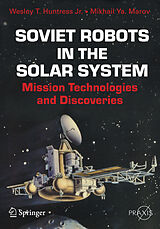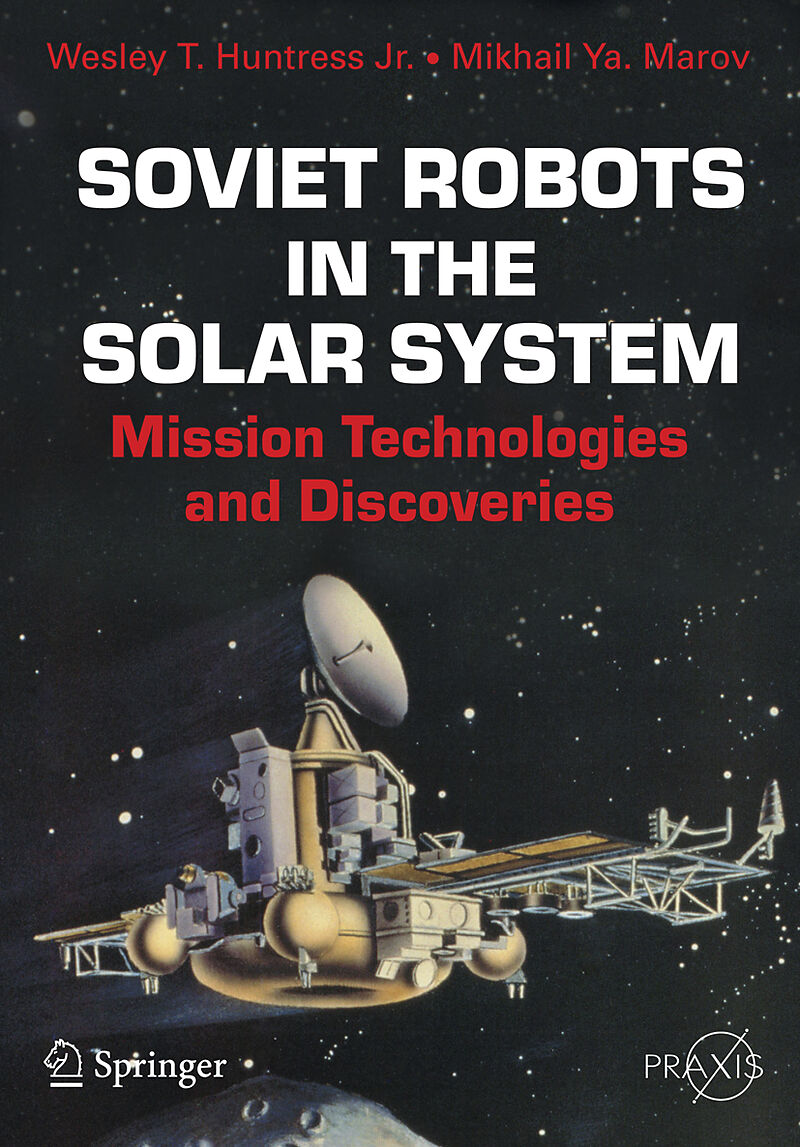Soviet Robots in the Solar System
Einband:
Kartonierter Einband
EAN:
9781441978974
Untertitel:
Mission Technologies and Discoveries
Autor:
Mikhail Ya Marov, Jr. Huntress
Herausgeber:
Springer New York
Auflage:
2011
Anzahl Seiten:
476
Erscheinungsdatum:
01.07.2011
ISBN:
1441978976
Written by the former head of NASA's robotic solar system exploration division, this book makes a unique contribution to understanding the scientific and engineering accomplishments of the USSR's robotic space exploration arm from its infancy to its demise.
Soviet Robots in the Solar System provides a history of the Soviet robotic lunar and planetary exploration program from its inception, with the attempted launch of a lunar impactor on September 23, 1958, to the last launch in the Russian national scientific space program in the 20th Century, Mars 96, on November 16, 1996. This title makes a unique contribution to understanding the scientific and engineering accomplishments of the Soviet Union's robotic space exploration enterprise from its infancy to its demise with the collapse of the Soviet Union. The authors provide a comprehensive account of Soviet robotic exploration of the Solar System for both popular space enthusiasts and professionals in the field. Technical details and science results are provided and put into an historical and political perspective in a single volume for the first time. The book is divided into two parts. Part I describes the key players and the key institutions that build and operate the hardware, the rockets that provide access to space, and the spacecraft that carry out the enterprise. Part II is about putting these pieces together to enable space flight and mission campaigns. Part II is written in chronological order beginning with the first launches to the Moon. Each chapter covers a particular period when specific mission campaigns were undertaken during celestially-determined launch windows. Each chapter begins with a short overview of the flight missions that occurred during the time period and the political and historical context for the flight mission campaigns, including what the Americans were doing at the time. The bulk of each chapter is devoted to the scientific and engineering details of that flight campaign. The spacecraft and payloads are examined with as much technical detail as is available today, the progress is described, and a synopsis of the scientific result is given.
Presents a detailed, technical description of Soviet robotic space flights Provides an historical timeline of missions and programs in the context of competition with the US Outlines Soviet planning in both a national and international political context Covers mission objectives, spacecraft engineering, flight details, scientific payload, and results Includes supplementary material: sn.pub/extras
Autorentext
Dr. Wesley T. Huntress, Jr., is currently Director Emeritus at the Geophysical Laboratory of the Carnegie Institution of Washington. The author was the widely respected Director of NASA's Solar System Exploration Directorate from 1990 to 1992, and then Associate Administrator for Space Science from 1993 to 1998, where he was responsible for all of NASA's robotic science missions. During this time, and throughout his long and distinguished career, Dr. Huntress, Jr. has had a regular and sustained contact and interaction with the Russians. He has gained great appreciation of the Russian robotic exploration program of the Moon and the planets during the 20th century.Mikhail Marov is a long-time veteran of the Soviet scientific space program with experience on many past missions beginning the early 1970s and is currently at the Vernadsky Institute of Geochemistry in Moscow, one of the two principal scientific institutes involved in the Russian space program. He is well known internationally and is one of the most recognizable Russian experts in space science and exploration around the world.
Klappentext
The Soviet robotic space exploration program began in a spirit of bold adventure and technical genius. It ended after the fall of the Soviet Union and the failure of its last mission to Mars in 1996. Soviet Robots in the Solar System chronicles the scientific and engineering accomplishments of this enterprise from its infancy to its demise. Each flight campaign is set into context of national politics and international competition with the United States.Together with its many detailed illustrations and images, Soviet Robots in the Solar Systempresents the most detailed technical description of Soviet robotic space flightsprovides a unique insight into programmatic, engineering, and scientific issuescovers mission objectives, spacecraft engineering, flight details, scientific payload and resultsdescribes in technical depth Soviet lunar and planetary probes
Zusammenfassung
Soviet Robots in the Solar System provides a history of the Soviet robotic lunar and planetary exploration program from its inception, with the attempted launch of a lunar impactor on September 23, 1958, to the last launch in the Russian national scientific space program in the 20th Century, Mars 96, on November 16, 1996. This title makes a unique contribution to understanding the scientific and engineering accomplishments of the Soviet Union's robotic space exploration enterprise from its infancy to its demise with the collapse of the Soviet Union. The authors provide a comprehensive account of Soviet robotic exploration of the Solar System for both popular space enthusiasts and professionals in the field. Technical details and science results are provided and put into an historical and political perspective in a single volume for the first time. The book is divided into two parts. Part I describes the key players and the key institutions that build and operate the hardware, the rockets that provide access to space, and the spacecraft that carry out the enterprise. Part II is about putting these pieces together to enable space flight and mission campaigns. Part II is written in chronological order beginning with the first launches to the Moon. Each chapter covers a particular period when specific mission campaigns were undertaken during celestially-determined launch windows. Each chapter begins with a short overview of the flight missions that occurred during the time period and the political and historical context for the flight mission campaigns, including what the Americans were doing at the time. The bulk of each chapter is devoted to the scientific and engineering details of that flight campaign. The spacecraft and payloads are examined with as much technical detail as is available today, the progress is described, and a synopsis of the scientific result is given.
Inhalt
Illustrations.- Author's Preface.- Acknowledgments.- Part 1: The pieces: people, institutions, rockets and spacecraft.- Chapter 1: Space race.- Chapter 2: Key players.- Chapter 3: Key institutions.- Chapter 4: Rockets.- Chapter 5: Spacecraft.- Part II: Putting the pieces together: flying to the Moon, Venus, and Mars.- Chapter 6: Breaking free of Earth.- Chapter 7: Launching to Mars and Venus.- Chapter 8: New spacecraft, new failures.- Chapter 9: Three more years of frustration.- Chapter 10: Finally success at the Moon and Venus, but Mars eludes.- Chapter 11: Robotic achievements in the shadow of Apollo.- Chapter 12: Landing on the Moon, Venus, and Mars.- Chapter 13: Closeouts on a Venus spacecraft, a Moon rocket, and desperation at Mars.- Chapter14: Turning from the Moon and Mars to Venus.- Chapter 15: Repeating success at Venus.- Chapter 16: Back to Venus again.- Chapter 17: And back to Venus yet again.- Chapter 18: The International Comet Halley campaign.- Chapter 19: Another tryat Mars and its moon Phobos.- Chapter 20: The last gasp: Mars-96.- Chapter 21: The Soviet lunar and planetary exploration legacy.- Appendices.- Bibliography.- Index.

Leider konnten wir für diesen Artikel keine Preise ermitteln ...
billigbuch.ch sucht jetzt für Sie die besten Angebote ...
Die aktuellen Verkaufspreise von 5 Onlineshops werden in Realtime abgefragt.
Sie können das gewünschte Produkt anschliessend direkt beim Anbieter Ihrer Wahl bestellen.
Loading...
Die aktuellen Verkaufspreise von 5 Onlineshops werden in Realtime abgefragt.
Sie können das gewünschte Produkt anschliessend direkt beim Anbieter Ihrer Wahl bestellen.
| # | Onlineshop | Preis CHF | Versand CHF | Total CHF | ||
|---|---|---|---|---|---|---|
| 1 | Seller | 0.00 | 0.00 | 0.00 |
